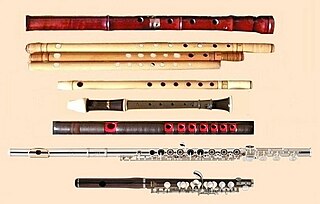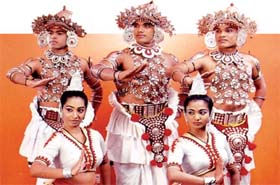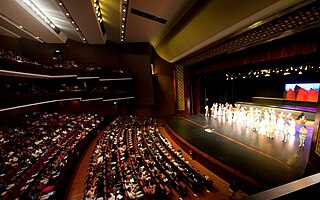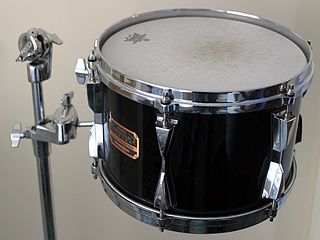Related Research Articles

A percussion instrument is a musical instrument that is sounded by being struck or scraped by a beater including attached or enclosed beaters or rattles struck, scraped or rubbed by hand or struck against another similar instrument. Excluding zoomusicological instruments and the human voice, the percussion family is believed to include the oldest musical instruments. In spite of being a very common term to designate instruments, and to relate them to their players, the percussionists, percussion is not a systematic classificatory category of instruments, as described by the scientific field of organology. It is shown below that percussion instruments may belong to the organological classes of ideophone, membranophone, aerophone and cordophone.

Sinhalese people are an Indo-Aryan ethno-linguistic group native to the island of Sri Lanka. They were historically known as Hela people. They constitute about 75% of the Sri Lankan population and number more than 16.2 million. The Sinhalese identity is based on language, cultural heritage and nationality. The Sinhalese people speak Sinhala, an insular Indo-Aryan language, and are predominantly Theravada Buddhists, although a minority of Sinhalese follow branches of Christianity and other religions. Since 1815, they were broadly divided into two respective groups: The 'Up-country Sinhalese' in the central mountainous regions, and the 'Low-country Sinhalese' in the coastal regions; although both groups speak the same language, they are distinguished as they observe different cultural customs.

In organology, the study of musical instruments, many methods of classifying instruments exist. Most methods are specific to a particular cultural group and were developed to serve that culture's musical needs. Culture-based classification methods sometimes break down when applied outside that culture. For example, a classification based on instrument use may fail when applied to another culture that uses the same instrument differently.

An aerophone is a musical instrument that produces sound primarily by causing a body of air to vibrate, without the use of strings or membranes, and without the vibration of the instrument itself adding considerably to the sound.

Religious music is a type of music that is performed or composed for religious use or through religious influence. It may overlap with ritual music, which is music, sacred or not, performed or composed for or as ritual. Religious songs have been described as a source of strength, as well as a means of easing pain, improving one's mood, and assisting in the discovery of meaning in one's suffering. While style and genre vary broadly across traditions, religious groups still share a variety of musical practices and techniques.
The music of Sri Lanka has its roots in five primary influences: ancient folk rituals, Hindu religious traditions, Buddhist religious traditions, the legacy of European colonisation, and the commercial and historical influence of nearby Indian culture—specifically, Kollywood cinema and Bollywood cinema.
A hand drum is any type of drum that is typically played with the bare hand rather than a stick, mallet, hammer, or other type of beater.

Buddhist symbolism is the use of symbols to represent certain aspects of the Buddha's Dharma (teaching). Early Buddhist symbols which remain important today include the Dharma wheel, the Indian lotus, the three jewels and the Bodhi tree.

The music of Vanuatu may refer to any kind of music played in the country of Vanuatu.

Punta is an Afro-indigenous dance and cultural music originating in the Caribbean Island of Saint Vincent And The Grenadines by the Garifuna people before being exiled from the island. Which is also known as Yurumei. It has African and Arawak elements which are also the characteristics of the Garifuna language. Punta is the best-known traditional dance belonging to the Garifuna community. It is also known as banguity or bunda, before the first arrival of the Garifuna people in Punta Gorda, Roatan, Honduras on April 12, 1797.

The rebana or terbangan is a tambourine that is used in Islamic devotional music in Southeast Asia, particularly in Indonesia, Malaysia, Brunei, and Singapore. The sound of the rebana often accompany Islamic ritual such as the zikir. The name rebana came from the Arabic word robbana. The rebana is also used by the Cham people of Cambodia and also gave rise to the Rabana which is used by the Sinhalese people of Sri Lanka.

The taepyeongso is a Korean double reed wind instrument in the shawm or oboe family, probably descended from the Persian sorna and closely related to the Chinese suona. It has a conical wooden body made from yuja (citron), daechu (jujube), or yellow mulberry wood, with a metal mouthpiece and cup-shaped metal bell. It originated during the Goryeo period (918–1392).

Kandyan dance encompasses various dance forms popular and native to the area called Kandy of the Central Hills region known as Udarata in Sri Lanka, which have today spread to other parts of the country. It is an example of Sinhalese culture in Sri Lanka.

The Kandy Esala Perahera also known as The Festival of the Tooth is a festival held in July and August in Kandy, Sri Lanka. This historical procession is held annually to pay homage to the Sacred Tooth Relic of Buddha, which is housed at the Sri Dalada Maligawa in Kandy. A unique symbol of Sri Lanka, the procession consists of traditional local dances such as fire dances and performances in whip-dance garments. The festival ends with the traditional Diya-kepeema ritual, a water cutting ceremony which is held at the Mahaweli River at Getambe, Kandy.

There are several styles of classical and folk dance in Sri Lanka.
Kshetram vadyam is the ritual music of South India. This is the main traditional music of Kerala state. It is a percussion dominated music.

Dancing in Zimbabwe is an important aspect of the Zimbabwean culture, tradition, spirituality and history. There are many dances that reflect the culture of the people, although the dances may have changed throughout the years. Ethnic diversity is also a key factor in influencing the dances of the Zimbabwean culture. These dances are self-reflective, for the entire community because all music and dance are communal events. Dance to Zimbabweans is a very spiritual, powerful tool that carries on traditions, and chronicles the important events of their history and culture.

The Theatre of Sri Lanka encompasses many different languages and traditions. Sinhalese language theatre originated from traditional rituals and folk dramas in the 19th century. Until that period, the art was confined to small villages and didn't have a national presence. Influential dramatist Ediriweera Sarachchandra attributes this to the influence of Theravada Buddhism, which he believes to have "tended more toward solitary contemplation and the attainment of insight than towards congregational practices or participation in community life".

A tom drum is a cylindrical drum with no snares, named from the Anglo-Indian and Sinhala language. It was added to the drum kit in the early part of the 20th century. Most toms range in size between 6 and 20 inches in diameter, though floor toms can go as large as 24 inches (61 cm).

A musical instrument is a device created or adapted to make musical sounds. In principle, any object that produces sound can be considered a musical instrument—it is through purpose that the object becomes a musical instrument. A person who plays a musical instrument is known as an instrumentalist. The history of musical instruments dates to the beginnings of human culture. Early musical instruments may have been used for rituals, such as a horn to signal success on the hunt, or a drum in a religious ceremony. Cultures eventually developed composition and performance of melodies for entertainment. Musical instruments evolved in step with changing applications and technologies.
References
- ↑ Monks, Priests and Peasants . Brill Archive
- ↑ Seneviratna, Anuradha (January 1979). "Pañcatūrya Nāda and the Hēwisi Pūjā". Ethnomusicology. University of Illinois Press. 23 (1): 49–56. doi:10.2307/851337. JSTOR 851337.
- ↑ "Manoj Peiris - Hakk Gediya". YouTube . March 8, 2010.